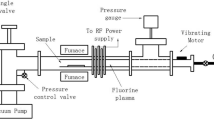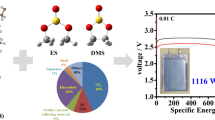Abstract
In this paper, the effects of ordinary multiwalled carbon nanotubes (MWCNTs) interlayer and novel fluorinated carbon nanotube (F-MWCNTs) interlayer on the electrochemical performance of lithium–sulfur (Li–S) batteries were investigated. After fluorination of graphitized MWCNTs, F-WMCNTs with a core–shell structure (fluorocarbon atomic ratio C/F = 1:1) can be obtained. The surface of F-WMCNTs was fluorinated to form a fluorinated carbon structure, while the internal structure of the original MWCNTs remains. F-MWCNTs/MWCNTs and cellulose fibers form a 3D crosslinked network structure, which effectively captures polysulfides. This layer was confirmed by scanning electron microscope (SEM), transmission electron microscope (TEM), and X-ray photoelectron spectroscopy (XPS). The F-MWCNTs interlayer Li–S battery maintained specific capacities of 1026 mAh/g, 938 mAh/g, and 764 mAh/g at 1C, 2C, and 3C, respectively, showing excellent rate performance.






Similar content being viewed by others
References
K. Zhou, M. Hu, Y. He et al., Transition metal assisted synthesis of tunable pore structure carbon with high performance as sodium/lithium ion battery anode. Carbon 129, 667–673 (2018)
H. Shang, Z. Zuo, L. Yu et al., Low-temperature growth of all-carbon graphdiyne on a silicon anode for high-performance lithium-ion batteries. Adv. Mater. 30(27), 1801459 (2018)
K. Yang, L. Zhong, R. Guan, M. Xiao, D. Han, S. Wang, Y. Meng, Carbon felt interlayer derived from rice paper and its synergistic encapsulation of polysulfides for lithium-sulfur batteries. Appl. Surf. Sci. 441, 914–922 (2018). https://doi.org/10.1016/j.apsusc.2018.02.108
Y. Wang, G. Wang, P. He et al., Sandwich structured NASICON-type electrolyte matched with sulfurized polyacrylonitrile cathode for high performance solid-state lithium-sulfur batteries. Chem. Eng. J. 393, 124705 (2020)
A. Zhang, X. Fang, C. Shen, Y. Liu, I.G. Seo, Y. Ma et al., Functional interlayer of PVDF-HFP and carbon nanofiber for long-life lithium-sulfur batteries. Nano Res. 11(6), 3340–3352 (2018). https://doi.org/10.1007/s12274-017-1929-0
H. Tang, S. Yao, S. Xue, M. Liu, L. Chen, M. Jing et al., In-situ synthesis of carbon@Ti4O7 non-woven fabric as a multi-functional interlayer for excellent lithium-sulfur battery. Electrochim. Acta 263, 158–167 (2018)
Z. Li, Z. Ma, Y. Wang, R. Chen, Z. Wu, S. Wang, LDHs derived nanoparticle-stacked metal nitride as interlayer for long-life lithium sulfur batteries. Sci. Bull. 63(3), 169–175 (2018). https://doi.org/10.1016/j.scib.2017.12.018
Y.V. Mikhaylik, J.R. Akridge, Polysulfide shuttle study in the Li/S battery system. J. Electrochem. Soc. 151(151), A1969–A1976 (2004)
A.F. Hofmann, D.N. Fronczek, W.G. Bessler, Mechanistic modeling of polysulfide shuttle and capacity loss in lithium–sulfur batteries. J. Power Sources 259(259), 300–310 (2014)
A. Vizintin, M. Lozinsek, R.K. Chellappan et al., Fluorinated reduced graphene oxide as an interlayer in Li–S batteries. Chem. Mater. 27(20), 7070–7081 (2015)
Y. Li, X. Wu, C. Liu et al., Fluorinated multi-walled carbon nanotubes as cathode materials of lithium and sodium primary batteries: effect of graphitization of carbon nanotubes. J. Mater. Chem. 7(12), 7128–7137 (2019)
Y.S. Su, A. Manthiram, Lithium-sulphur batteries with a microporous carbon paper as a bifunctional interlayer. Nat. Commun. 3, 1166 (2012)
V.V. Viswanathan, D. Choi, D. Wang et al., Effect of entropy change of lithium intercalation in cathodes and anodes on Li-ion battery thermal management. J. Power Sources 195(11), 3720–3729 (2010)
S.S. Zhang, D. Foster, J. Read et al., Enhancement of discharge performance of Li/CFx cell by thermal treatment of CFx cathode material. J. Power Sources 188(2), 601–605 (2009)
R. Jayasinghe, A.K. Thapa, R.R. Dharmasena et al., Optimization of multi-walled carbon nanotube based CF_x electrodes for improved primary and secondary battery performances. J. Power Sources 253(MAY 1), 404–411 (2014)
P. Rajkumar, K. Diwakar, G. Radhika et al., Effect of silicon dioxide in sulfur/carbon black composite as a cathode material for lithium sulfur batteries. Vacuum 161, 37–48 (2019)
R. Hu, Y. Ouyang, T. Liang, H. Wang, J. Liu, J. Chen et al., Stabilizing the nanostructure of SnO2 anodes by transition metals: a route to achieve high initial Coulombic efficiency and stable capacities for lithium storage. Adv. Mater. 29(13), 1605006 (2017). https://doi.org/10.1002/adma.201605006
J. Zou, X. Sun, R. Li et al., CNT network crosslinked by metal Co2+ for stabilizing SnO2 anodes. Synth. Met. 257, 116145 (2019)
S. Wu, C. Liu, D.A. Dinh et al., Three-dimensional self-standing and conductive MnCO3@graphene/CNT networks for flexible asymmetric supercapacitors. ACS Sustain. Chem. Eng. 7(11), 9763–9770 (2019)
C. Li, P. Zhang, J. Dai et al., Rational method for improving the performance of lithium-sulfur batteries: coating the separator with lithium fluoride. Chemelectrochem 4(6), 1535–1543 (2017)
L. Zhang, K. Zhao, R. Yu et al., Phosphorus enhanced intermolecular interactions of SnO2 and graphene as an ultrastable lithium battery anode. Small 13(20), 1603973 (2017)
Y. Guo, S. Jin, L. Wang et al., Synthesis of two-dimensional carbide Mo 2 CT x MXene by hydrothermal etching with fluorides and its thermal stability. Ceram. Int. 46, 19556 (2020)
Y.S. Lee, T.H. Cho, B.K. Lee et al., Surface properties of fluorinated single-walled carbon nanotubes. J. Fluorine Chem. 120(2), 99–104 (2003)
T. Hayashi, M. Terrones, C. Scheu et al., NanoTeflons: structure and EELS characterization of fluorinated carbon nanotubes and nanofibers. Nano Lett. 2(5), 491–496 (2002)
R. Zhuang, S. Yao, X. Shen et al., Electrospun β-Mo2C/CNFs as an efficient sulfur host for rechargeable lithium sulfur battery. J. Mater. Sci.: Mater. Electron. 30(5), 4626–4633 (2019)
M.Q. Zhao, Q. Zhang, J.Q. Huang et al., Unsed double-layer templatedgraphene for high-rate lithium–sulphur batteries. Nat. Commun. 5(5), 3410 (2014)
H.A. Salem, G. Babuu, C.V. Rao et al., Electrocatalytic polysulfide traps for controlling redox shuttle process of Li–S batteries. J. Am. Chem. Soc. 137(36), 11542 (2015)
C. Zu, A. Manthiram, Hydroxylated grapheme-sulfur nanocomposites for high-rate lithium-sulfur batteries. Adv. Energy Mater. 3(8), 1008–1012 (2013)
Z. Xiao, Z. Yang, L. Wang et al., A lightweight TiO2/graphene interlayer, applied as a highly effective polysulfide absorbent for fast, long-life lithium-sulfur batteries. Adv. Mater. 27(18), 2891–2898 (2015)
K.H. An, J.G. Heo, K.G. Jeon et al., X-ray photoemission spectroscopy study of fluorinated single-walled carbon nanotubes. Appl. Phys. Lett. 80(22), 4235–4237 (2002)
H.F. Bettinger, K.N. Kudin, G.E. Scuseria, Thermochemistry of fluorinated single wall carbon nanotubes. J. Am. Chem. Soc. 123(51), 12849–12856 (2001)
K.N. Kudin, H.F. Bettinger, G.E. Scuseria, Fluorinated single-wall carbon nanotubes. Phys. Rev. B 63(4), 045413 (2001)
G. Greczynski, L. Hultman, X-ray photoelectron spectroscopy: towards reliable binding energy referencing. Prog. Mater Sci. 107, 100591 (2019)
Z. Zhou, Y. Xu, W. Liu et al., High capacity Si/DC/MWCNTs nano composite anode materials for lithium ion batteries. J. Alloys Compd. 493(1), 636–639 (2010)
Y. Li, Y.F. Chen, Y.Y. Feng et al., Progress of synthesizing methods and properties of fluorinated carbon nanotubes. Sci. China 05, 1225–1233 (2010)
M.M. Brzhezinskaya, A.S. Vinogradov, A.V. Krestinin, G.I. Zvereva, A.P. Kharitonov, I.I. Kulako, Comparative X-ray absorption investigation of fluorinated single-walled carbon nanotubes. Phys. Solid State 52(4), 876–883 (2010)
H.Y. Zhou, Z.Y. Sui, F. Zhao et al., A nanostructured porous carbon/MoO2 composite with efficient catalysis in polysulfide conversion for lithium–sulfur batteries. Nanotechnology 31(31), 315601 (2020)
L. Yan, N. Luo, W. Kong et al., Enhanced performance of lithium-sulfur batteries with an ultrathin and lightweight MoS 2/carbon nanotube interlayer. J. Power Sources 389(JUN.15), 169–177 (2018)
Z. Li, F. Zhang, L. Tang et al., High areal loading and long-life cycle stability of lithium-sulfur batteries achieved by a dual-function ZnS-modified separator. Chem. Eng. J. 390, 124653 (2020)
L. Jiao, C. Zhang, C. Geng et al., Capture and catalytic conversion of polysulfides by in situ built TiO_2-MXene heterostructures for lithium-sulfur batteries. Adv. Energy Mater. 9(19), 1900219.1-1900219.9 (2019)
L. Jie, C. Chao, Q. Furong et al., Mesoporous Co–N–C composite as a sulfur host for high-capacity and long-life lithium–sulfur batteries. J. Mater. Sci. 53, 13143–13155 (2018)
W. Hua, Z. Yang, H. Nie et al., Polysulfide-scission reagents for the suppression of the shuttle effect in lithium-sulfur batteries. ACS Nano 11(2), 2209–2218 (2017)
X. Han, Y. Xu, X. Chen et al., Reactivation of dissolved polysulfides in Li–S batteries based on atomic layer deposition of Al2O3 in nanoporous carbon cloth. Nano Energy 2(6), 1197–1206 (2013)
Y. Sun, G. Ning, C. Qi et al., An advanced lithium ion battery based on a sulfur-doped porous carbon anode and a lithium iron phosphate cathode. Electrochim. Acta 190, 141–149 (2016)
B. Zhao, H. Zhuang, Y. Yang et al., Composition-dependent lithium storage performances of SnS/SnO2 heterostructures sandwiching between spherical graphene. Electrochim. Acta 300, 253–262 (2019)
J. Wang, F. Fang, T. Yuan et al., Three-dimensional graphene/single-walled carbon nanotube aerogel anchored with SnO2 nanoparticles for high performance lithium storage. ACS Appl. Mater. Interfaces 9(4), 3544–3553 (2017)
J. Leng, Z. Wang, J. Wang et al., Advances in nanostructures fabricated via spray pyrolysis and their applications in energy storage and conversion. Chem. Soc. Rev. 48(11), 3015–3072 (2019)
Y. Cen, Y. Fan, Q. Qin et al., Synthesis of Si anode with a microsized-branched structure from recovered Al scrap for use in Li-Ion batteries. J. Power Sources 410, 31–37 (2019)
H. Cho, K. Kim, C.M. Park et al., In situ fabrication of nanohybrid carbon/polyamide film providing robust binding and conductive network in silicon anode for lithium-ion battery. J. Power Sources 410, 25–30 (2019)
Z. Qiu, Y. Nie, X. Sun et al., Electrochemical performance of nano-SnO2 anode with carbonized carbon nanotubes paper as host. J. Electron. Mater. 47(10), 5850–5857 (2018)
Z. Liu, X. Yuan, S. Zhang et al., Three-dimensional ordered porous electrode materials for electrochemical energy storage. NPG Asia Mater. 11(1), 1–21 (2019)
K. Wang, J. Huang, A bioinspired three-dimensional nanofibrous Cu-nanoparticle/SnO2/carbon composite as an anodic material for lithium-ion battery. Appl. Surf. Sci. 476, 293–302 (2019)
Acknowledgements
The authors are grateful to the Jiangxi scientific fund (20142BBE50071) and Jiangxi education fund (KJLD13006).
Author information
Authors and Affiliations
Corresponding author
Ethics declarations
Conflict of interest
We declare that we do not have any commercial or associative interest that represents a conflict of interest in connection with the work submitted.
Additional information
Publisher's Note
Springer Nature remains neutral with regard to jurisdictional claims in published maps and institutional affiliations.
Rights and permissions
About this article
Cite this article
Li, R., Sun, X., Zou, J. et al. Improvement of electrochemical performance by fluorinated multiwall carbon nanotubes interlayer in lithium–sulfur battery. J Mater Sci: Mater Electron 32, 8265–8274 (2021). https://doi.org/10.1007/s10854-020-05233-2
Received:
Accepted:
Published:
Issue Date:
DOI: https://doi.org/10.1007/s10854-020-05233-2




